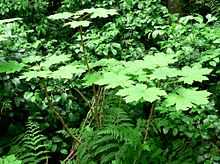Devil's Club
| Devil's club | |
|---|---|
| | |
| Flowers and bumblebees | |
| Scientific classification | |
| Kingdom: | Plantae |
| (unranked): | Angiosperms |
| (unranked): | Eudicots |
| (unranked): | Asterids |
| Order: | Apiales |
| Family: | Araliaceae |
| Subfamily: | Aralioideae |
| Genus: | Oplopanax |
| Species: | O. horridus |
| Binomial name | |
| Oplopanax horridus (Sm.) Miq. | |
| Synonyms | |
|
Echinopanax horridum[1] | |
Devil's club or devil's walking stick (Oplopanax horridus, Araliaceae; syn. Echinopanax horridus, Fatsia horrida[2]) is a large shrub primarily native to the cool moist forests of western North America, but also disjunct on islands in Lake Superior. It is noted for its large palmate leaves and erect, woody stems covered in brittle spines. It is also known as Alaskan ginseng and similar names, but it is not a true ginseng. True ginseng is in the genus Panax. Since 2002, in the United States it has been illegal to market non-Panax products as ginseng.[3]
Description
Devil's club generally grows to 1 to 1.5 metres (3 ft 3 in to 4 ft 11 in) tall; however, instances exist of it reaching in excess of 5 metres (16 ft) in rainforest gullies. The spines are found along the upper and lower surfaces of veins of its leaves as well as the stems. The leaves are spirally arranged on the stems, simple, palmately lobed with 5-13 lobes, 20 to 40 centimetres (7.9 to 15.7 in) across. The flowers are produced in dense umbels 10 to 20 centimetres (3.9 to 7.9 in) diameter, each flower small, with five greenish-white petals. The fruit is a small red drupe 4 to 7 millimetres (0.16 to 0.28 in) diameter.[2]
The plant is covered with brittle yellow spines that break off easily if the plants are handled or disturbed, and the entire plant has been described as having a "primordial" appearance. Devil's club is very sensitive to human impact and does not reproduce quickly. The plants are slow growing and take many years to reach seed bearing maturity, and predominately exist in dense, moist, old growth conifer forests in the Pacific Northwest.[2]
Habitat
This species usually grows in moist, dense forest habitats, and is most abundant in old growth conifer forests. It is found from Southcentral Alaska to western Oregon and eastward to western Alberta and Montana. Disjunct native populations also occur over 1,500 kilometres (930 mi) away in Lake Superior on Isle Royale and Passage Island, Michigan and Porphyry Island and Slate Island, Ontario.
Propagation
Devil's club reproduces by forming clonal colonies through a layering process. What can appear to be several different plants may actually have all been one plant originally, with the clones detaching themselves after becoming established by laying down roots.[4]
Uses

Native Americans used the plant as medicine.[5] The plant was traditionally used by Native Americans to treat adult-onset diabetes, as well as rheumatoid arthritis. Traditionally, it was and is still used to make paints. In vitro studies showed that extracts of Devil's Club inhibit tuberculosis microbes.[6] Additionally, Devil's club has been seen to extend life expectancy and reduce leukemia burden in rats engrafted with acute myeloid leukemia.[7]
The plant is used medicinally and ceremonially by the Tlingit and Haida people of Southeast Alaska. A piece of Devil's club hung over a doorway is said to ward off evil. The plant is harvested and used in a variety of ways, including poultices applied externally and ointments, however the consumption of an oral tea is most common in traditional settings. Some Tlingit disapprove of the commercialization of the plant as they see it as a violation of its sacred status. [8] (Or perhaps as a violation of their intellectual property rights, being a potlatch culture.)
Because Devil's club is related to American Ginseng, some think that the plant is an adaptogen. The plant has been harvested for this purpose and marketed widely as "Alaskan ginseng",[9] which may damage populations of Devil's Club and its habitat. The genus Panax ('true' ginseng) is exceptional among Araliaceae both morphologically and chemically. Other, even closely related plants with proven adaptogen effects, such as Eleutherococcus senticosus the "Siberian ginseng", are chemically dissimilar to Panax ginseng.[10]
Notes
- ↑ Hulten, Eric (1968). Flora of Alaska and Neighboring Territories. ISBN 0-8047-0643-3.
- ↑ 2.0 2.1 2.2 Pojar, Jim; Andy MacKinnon (1994). Plants of Coastal British Columbia. BC Ministry of Forests and Lone Pine Publishing. p. 82. ISBN=1-55105-042-0.
- ↑ Davis, Jeanine; Persons, W. Scott (2014). Growing and Marketing Ginseng, Goldenseal and other Woodland Medicinals. Gabriola Island, BC: New Society Publishers. pp. 12–15. ISBN 978-0-86571-766-4.
- ↑ Trevor C. Lantz and Joseph A. Antos (2002). "Clonal expansion in the deciduous understory shrub, devil's club". Can. J. Bot. 80 (10): 1052–1062. doi:10.1139/b02-095.
- ↑ Turner, Nancy J. (May 1982). "Traditional Use of Devil's-Club (Oplopanax horridus; Araliaceae) by Native Peoples in Western North America". J. Ethnobiol. Society of Ethnobiology. Retrieved 28 February 2013.
- ↑ Inui T, Wang Y, Deng S, Smith DC, Franzblau SG, Pauli GF (Jun 1, 2000). "Counter-current chromatography based analysis of synergy in an anti-tuberculosis ethnobotanical". Journal of Chromatography A 1151 (1–2): 211–5. doi:10.1016/j.chroma.2007.01.127. PMC 2533621. PMID 17316661.
- ↑ McGill, et. al. "Extracts of Devil's Club (Oplopanax horridus) Exert Therapeutic Efficacy in Experimental Models of Acute Myeloid Leukemia". Wiley Online Library. Retrieved 1 July 2014.
- ↑ Levine, Ketzel Use of devil's club plant central to Tlingit culture National Public Radio Morning Edition, 8/11/2004
- ↑ http://www.google.com/search?q=alaskan+ginseng&ie=UTF-8&oe=UTF-8
- ↑ Davydov M, Krikorian AD (2000). "Eleutherococcus senticosus (Rupr. & Maxim.) Maxim. (Araliaceae) as an adaptogen: a closer look". J Ethnopharmacol. 72 (3): 345–93. doi:10.1016/S0378-8741(00)00181-1. PMID 10996277.
External links
![]() Media related to Devil's Club at Wikimedia Commons
Media related to Devil's Club at Wikimedia Commons
- Michigan Natural Features Inventory -- Oplopanax horridus
- USDA plants profile: Oplopanax horridus
- Edibility of Devil's Club: Visual identification and edible parts of Devil's Club.